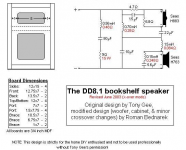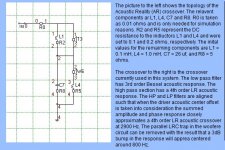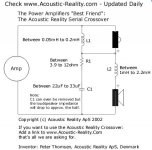There was enough difference in the frequency response to be audible even before you go trying each of the circuits in turn. Yes, I agree.
...And thus, it's not an apples to apples comparision.
It's worth mentioning that a series crossover's unusual mix of a midpass component into the high and lowpass filters can be done easily enough with parallel crossovers:
All you do is replace one drive unit with an 8 ohm resistor, double up, and you have your parallel wiring for the same transfer function....WITH NO CROSSTALK! 😎
The more I look at series crossovers, the less enamoured I am with them. Firstly, first order group delay is not a big deal. It is second order that is a bitch to equalise at radio frequencies. Secondly, it's just not realistic to run a tweeter off a first order for any decent power handling. You inevitably need steeper slopes with more group delay. Most real world series circuits are second order, unless you buy some very exotic flat, widerange woofers and tweeters. I enclose a typical realistic series crossover, and just for fun, the old respected Acoustic Research AR-4X, which was a first order butterworth, and therefore presumably had the same lack of group delay...😉
An externally hosted image should be here but it was not working when we last tested it.
All you do is replace one drive unit with an 8 ohm resistor, double up, and you have your parallel wiring for the same transfer function....WITH NO CROSSTALK! 😎
The more I look at series crossovers, the less enamoured I am with them. Firstly, first order group delay is not a big deal. It is second order that is a bitch to equalise at radio frequencies. Secondly, it's just not realistic to run a tweeter off a first order for any decent power handling. You inevitably need steeper slopes with more group delay. Most real world series circuits are second order, unless you buy some very exotic flat, widerange woofers and tweeters. I enclose a typical realistic series crossover, and just for fun, the old respected Acoustic Research AR-4X, which was a first order butterworth, and therefore presumably had the same lack of group delay...😉
Attachments
Sreten since guitar woofers have no crossover they are playing within their full range. It may not go very high in frequency though.
System7 you better get busy on the series crossover for Michelino.
When vodoo is involved there is no time to waste.
Group delay is a big deal. Hearing all the frequencies at the same time is what makes them sound more detailed.
I stated time delay in previous posts.
No different then flat baffle sound compared to sloped front cabinets sound.
When vodoo is involved there is no time to waste.
Group delay is a big deal. Hearing all the frequencies at the same time is what makes them sound more detailed.
I stated time delay in previous posts.
No different then flat baffle sound compared to sloped front cabinets sound.
JohnK. that is why a Re should be used in parallel of the tweeter.
It should be connected to the woofer Zoebel.
I am sure someone is going to ask why.
It should be pretty obvious.
It should be connected to the woofer Zoebel.
I am sure someone is going to ask why.
It should be pretty obvious.
Last edited:
Has anyone pointed ot the problem of intermodulation in series x-o's yet? The back EMF generated by each driver appears, in part or in whole, across the other driver.
This is what I'm waiting for, for my previous question. A technical explanation regarding series filter weakness, which correlate with the sound that I don't like with series speaker (that I have built or heard).
System7 posts 5 way series crossover by Saul Marantz. If some of the links I posted were carefully read Saul Marantz name came up in some of the Fried literature. They were good friends.
Ashley and Small found intermodulation distortion in MOST drivers .They didn't state all. That was in the 60's and 71 papers. Those drivers would have distortion problems attenuated in higher order crossovers. But there would still be diisitortion attenuated.
Many so called high end drivers have distortion problems.
It comes down to your opinion of high end drivers.
.
A high quality driver available back then compared today is far different Look at the tweeters available in those days
A cone tweeter is going to have a distrtion problem in any type of crossover.
Dynaudio was the first high quality domes available that had a low Fs that I am aware of.
Ashley and Small found intermodulation distortion in MOST drivers .They didn't state all. That was in the 60's and 71 papers. Those drivers would have distortion problems attenuated in higher order crossovers. But there would still be diisitortion attenuated.
Many so called high end drivers have distortion problems.
It comes down to your opinion of high end drivers.
.
A high quality driver available back then compared today is far different Look at the tweeters available in those days
A cone tweeter is going to have a distrtion problem in any type of crossover.
Dynaudio was the first high quality domes available that had a low Fs that I am aware of.
I have the links but I still don't see the point. He seems to be paying an inordinate amount of attention on making the total impedance an easy load for the amp. Is there anything in the pdf to demonstrate the superiority of series crossovers?
This is what I'm waiting for, for my previous question. A technical explanation regarding series filter weakness, which correlate with the sound that I don't like with series speaker (that I have built or heard).
Another factor with simple LC series x-o's s that you don't have control over the polar response. For example, if you use a simple LC series x-o and dittle with zeta to get flat response, the polar response changes as zeta changes. Additionally, for high zeta each section of the filter (HP and LP) rings around the x-o point and this ringing only cancels on the design axis. Furthermore, as zeta is increased the amplitude at the crossover point approaches and eventually exceeds unity for each band pass with the result that to have flat response there must be cancellation between the drivers. Finally, higher zeta leads to lower impedance around the crossover point.
Additionally, once additional reactive components are added in series with the driver, it is no longer a constant voltage crossover.
Finally, adding a resistor in parallel with a driver (tweeter or woofer) does not mitigate the problem of intermediation due to the back EMF generated by the drivers.
Similar and the same problems can be run into with parallel networks but it is much easier to control the response of each individual driver with a parallel network and the issue of intermediation through the back EMF does not arise.
AllenB resistive loads to amps I always thought was better then capacitive loads.
The same with driver loading being resistive.
Look how a closed box causes the driver to act capacitive compared to a t-line.
I have read of problem amplifiers. One forum user on another forum having a problem with the same amp I have running hot with his Infinity IRS speakers from the early 1980"s. Those speakers offer a capacitive load to the amp
My amp has never run hot. A resistive linear load is easier for the amp to drive .
I have had 2 pairs of satellite and subwoofers hooked up to my Parasound HCA-3500 and prefer the sound of just one pair. I prefer tube amps but draw the line when it comes to the price.
Fried goes into amps with his speakers on the IMF site literature. It takes a lot of time reading.
Fried loudspeakers - IMF electronics
The same with driver loading being resistive.
Look how a closed box causes the driver to act capacitive compared to a t-line.
I have read of problem amplifiers. One forum user on another forum having a problem with the same amp I have running hot with his Infinity IRS speakers from the early 1980"s. Those speakers offer a capacitive load to the amp
My amp has never run hot. A resistive linear load is easier for the amp to drive .
I have had 2 pairs of satellite and subwoofers hooked up to my Parasound HCA-3500 and prefer the sound of just one pair. I prefer tube amps but draw the line when it comes to the price.
Fried goes into amps with his speakers on the IMF site literature. It takes a lot of time reading.
Fried loudspeakers - IMF electronics
Thanks JohnK for the explanation. I'm more convinced now.
I didn't know if the polar response can be a problem with series filter. Soundwise they sound okay around its axis. But It could be, as I have never checked (doesn't have long experience in using them. The most successful one was used for a few months for bedroom system with low power tube amp).
It means that it is still possible with the simplest 1st order series, if the drivers allow for it.
From listening experience, it seems that the back EMF issue is the most serious drawback... (and it is inherent with the topology!)
Another factor with simple LC series x-o's s that you don't have control over the polar response.
I didn't know if the polar response can be a problem with series filter. Soundwise they sound okay around its axis. But It could be, as I have never checked (doesn't have long experience in using them. The most successful one was used for a few months for bedroom system with low power tube amp).
Additionally, once additional reactive components are added in series with the driver, it is no longer a constant voltage crossover.
It means that it is still possible with the simplest 1st order series, if the drivers allow for it.
Finally, adding a resistor in parallel with a driver (tweeter or woofer) does not mitigate the problem of intermediation due to the back EMF generated by the drivers.
From listening experience, it seems that the back EMF issue is the most serious drawback... (and it is inherent with the topology!)
Dynaudio use to sell their tweeters to the public.
When I purchased my first pair of raw drivers they only made the D-28H and D21H.
It was written on the box 6db per octave croosovers gave the lowest distortion. I think 4.7mfd 3500hz for 1000 watt peak power in 8 ohms.
The boxes are long gone. They did not state series or parallel. They gave all the technical reasons.
.
I would place higher vakue in their intended use since they created the tweeter.
When I purchased my first pair of raw drivers they only made the D-28H and D21H.
It was written on the box 6db per octave croosovers gave the lowest distortion. I think 4.7mfd 3500hz for 1000 watt peak power in 8 ohms.
The boxes are long gone. They did not state series or parallel. They gave all the technical reasons.
.
I would place higher vakue in their intended use since they created the tweeter.
..........
From listening experience, it seems that the back EMF issue is the most serious drawback... (and it is inherent with the topology!)
It should be kept in mind that series XO's lend themselves best to 2-way designs with relatively small mid/woofers like that shown in Planet10's schematic earlier. IMHO, small, mid/woofs back EMF can't be very much compared to relatively larger, dedicated woofers. Thus, back EMF effects may indeed be occuring; but to what degree does it happen in small, 2-ways and to what degree is it manifested acoustically?
I wonder if the 'intermediation' johnk speaks of can even be measured.
BTW, what is intermediation? Keyword searches result mostly in the definition being 'matching financial lenders to borrowers'. 😕
I wonder if the 'intermediation' johnk speaks of can even be measured.
BTW, what is intermediation? Keyword searches result mostly in the definition being 'matching financial lenders to borrowers'. 😕
Typo. Should have been "intermodulation". I didn't check the spell checker's substitution. 🙁
It should be kept in mind that series XO's lend themselves best to 2-way designs with relatively small mid/woofers like that shown in Planet10's schematic earlier. IMHO, small, mid/woofs back EMF can't be very much compared to relatively larger, dedicated woofers. Thus, back EMF effects may indeed be occuring; but to what degree does it happen in small, 2-ways and to what degree is it manifested acoustically?
I think that is not about 2-way design with small woofer (but SPL). But I like the "idea" behind that crossover by DaveR. I think it is very smart. I have copied the idea for my own implementations. Very useful.
Knowing that 1st order parallel is almost impossible to achieve, very simple series crossovers is still very powerful.
Most of this thread is just waffle, IMO. People are being incredibly secretive if you ask me. It's just physics really. Given how inefficient most drivers are, especially in successful series implementations, I really don't see back EMF as being a biggie. 🙂
Is anybody going to calculate the transfer function for a second-order series crossover? Or do I have to do EVERYTHING round here...🙄
Is anybody going to calculate the transfer function for a second-order series crossover? Or do I have to do EVERYTHING round here...🙄
Typo. Should have been "intermodulation". I didn't check the spell checker's substitution. 🙁
LOL! No disrespect intended. I just thought you might have coined a new audio term I needed a definition for. Most forums allow indefinite edits. Wish this one did myself a few times. 🙂)
Most of this thread is just waffle, IMO. People are being incredibly secretive if you ask me. It's just physics really. Given how inefficient most drivers are, especially in successful series implementations, I really don't see back EMF as being a biggie. 🙂
Is anybody going to calculate the transfer function for a second-order series crossover? Or do I have to do EVERYTHING round here...🙄
Agree with your EMF opinion.
I thought speakerman19422 was the expert. 🙄 At least he writes like one; and yet doesn't show any work. I guess it's all 'top secret', patentable audio stuff. 🙄
There was a troll over at TT who made lots of untrue statements and eventually was called out and he ultimately bailed. 😀
I will probably do the calculation for a series crossover with an additional capacitor and inductor for the two drivers. It's not hard, and I really am fed up with the lack of clear explanation so far. I had to do the sums myself to find out what was going on. In practise, you still add bafflestep and Zobels an stuff. There's an elegance here that interests me.
But I will, no doubt, revise my opinion based on the underlying science when it is revealed.
But I will, no doubt, revise my opinion based on the underlying science when it is revealed.
Attachments
I have given the clear explanation. The company I am referring to in many of their designs use the mibass driver mh and tweeter mh as the crossover frequency. What is so difficult to understand. Tweeter R2 value in 8ohm designs always the same, Tweeter R2 value for 4ohm designs always the same. If tweeter attenuation needed R1 is changed. Using a computer program for crossover design does nothing to help a person understand the theory.
- Status
- Not open for further replies.
- Home
- Loudspeakers
- Multi-Way
- Sreten & Speakerman go at series XOs



